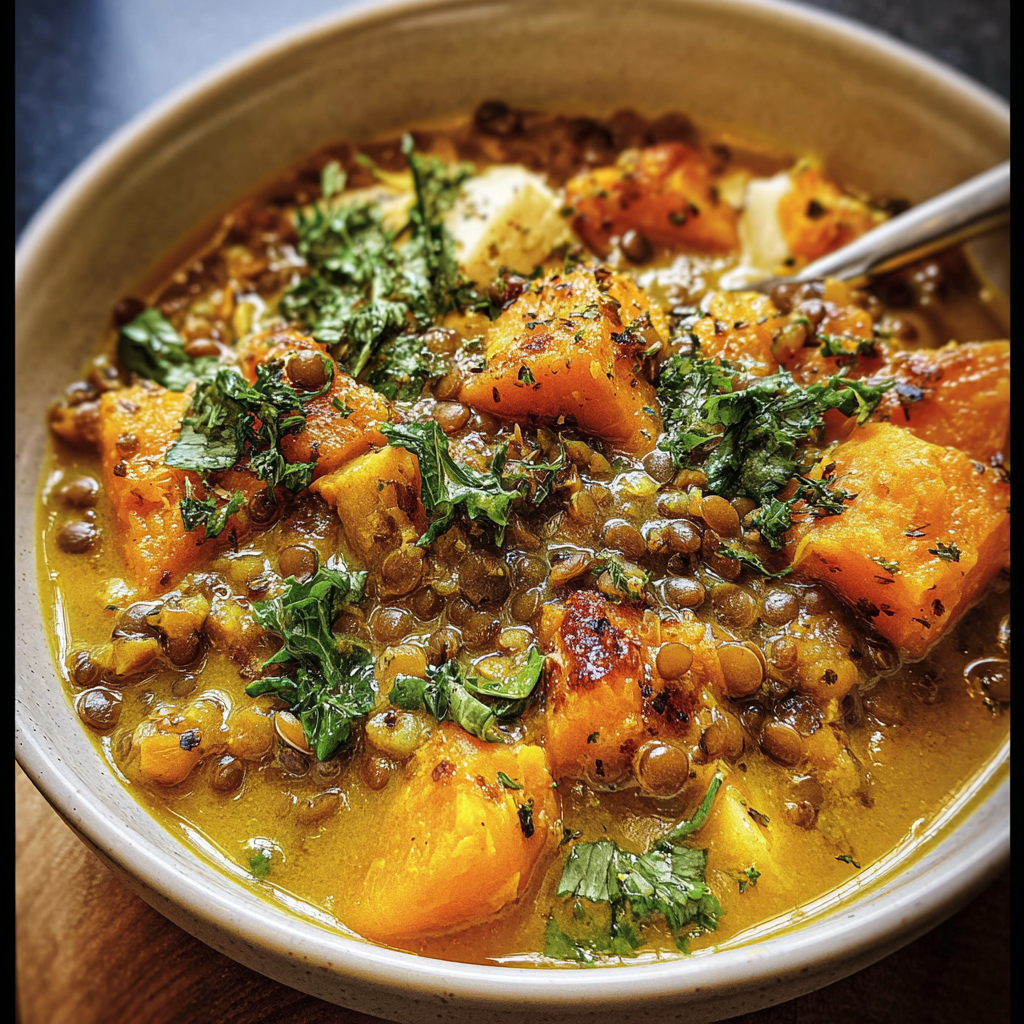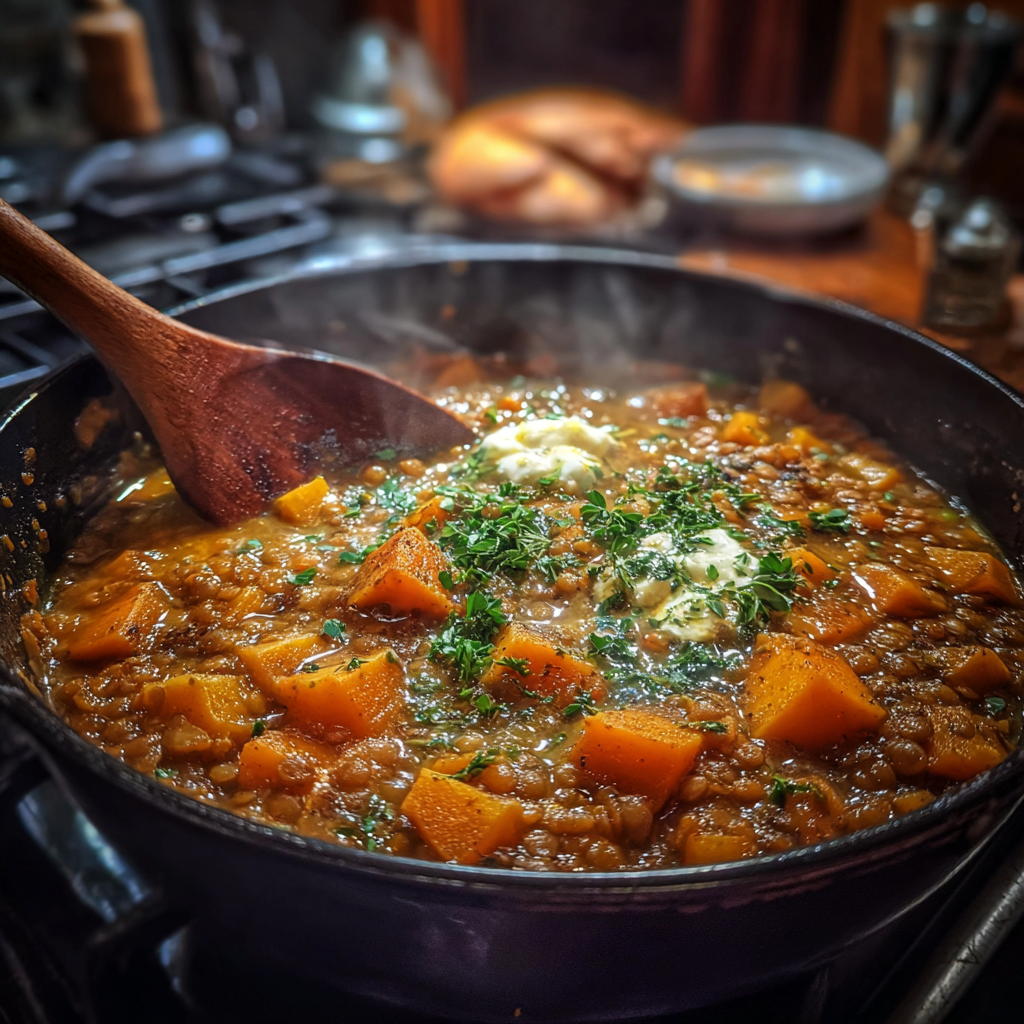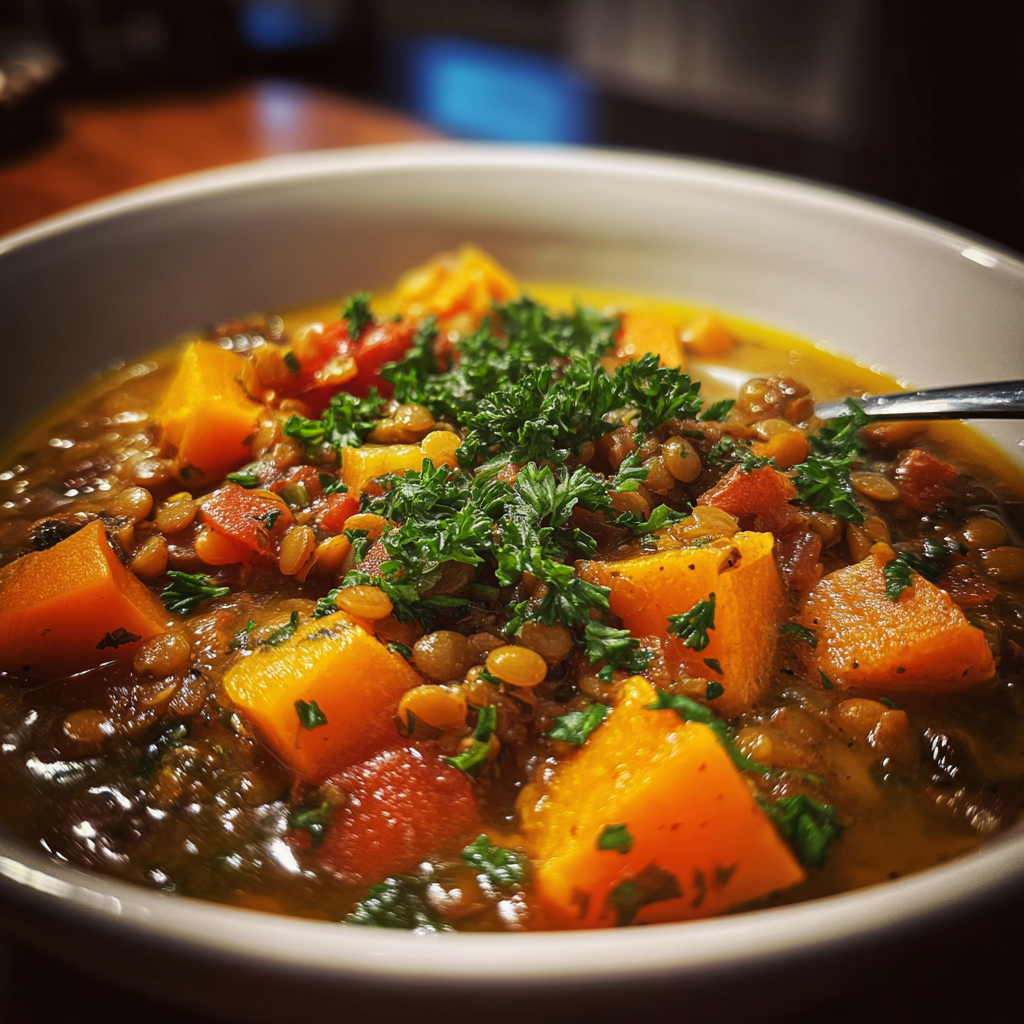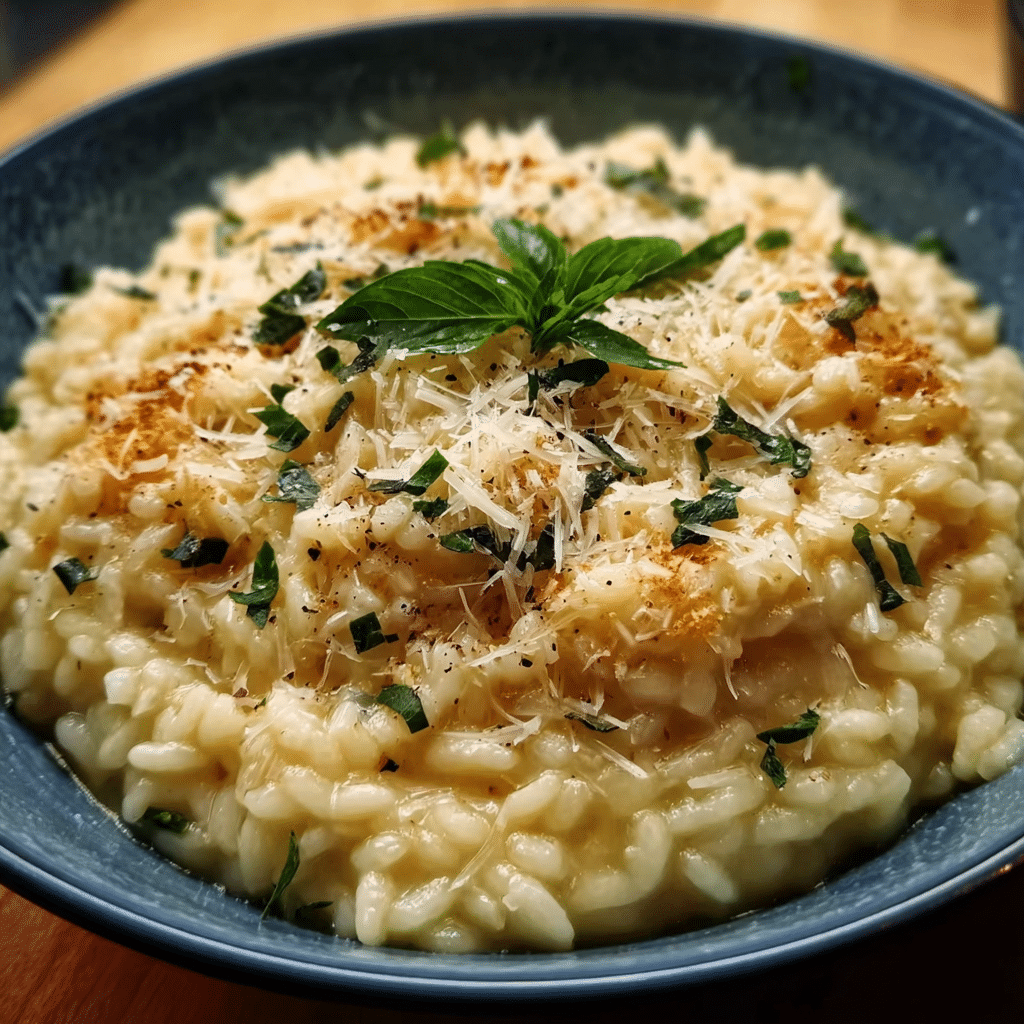Butternut lentil stew is one of those heartwarming dishes that beckons you to the kitchen, especially as the crisp autumn air begins to weave its way into our lives. It was during one of those chilly November evenings that I first stumbled upon this incredible recipe. I remember it vividly—I had just returned home from a long day of work, my stomach grumbling in protest, and the last thing I wanted to do was spend hours slaving away over a hot stove. As I rifled through my pantry, I came across a beautiful butternut squash, some dried lentils, and an assortment of spices that promised a culinary adventure. Little did I know, this would become a staple in my home and a dish that would bring my family together.

The moment I took that first spoonful of butternut lentil stew, I was transported. The creaminess of the squash blended perfectly with the earthy lentils while the spices danced on my palate. It was love at first taste! Since that fateful night, I’ve made it countless times, each occasion evoking memories of cozy dinners and laughter shared with loved ones. As I’ve experimented with the recipe over the years, I’ve come to appreciate not only the flavors but also the cultural significance woven into this dish.
The Story Behind This Recipe
Rooted in culinary traditions that span continents, butternut lentil stew is a dish that draws from various cultural heritages. Lentils have been cultivated for thousands of years, particularly in the Mediterranean, Middle Eastern, and Indian cuisines. They are celebrated not only for their versatility but also for their ability to nourish communities. The butternut squash, on the other hand, is a staple in North American cooking, particularly during the fall months when it is harvested fresh. Combining these ingredients creates a hearty, wholesome dish that transcends borders, bringing people together at the dinner table.
What makes butternut lentil stew particularly special is its adaptability. Unlike many traditional stews that require hours of cooking, this recipe can be whipped up in under an hour, making it perfect for busy families. Whether you’re coming home from work, shuttling kids to activities, or simply trying to squeeze in a moment of relaxation, you can prepare a nourishing meal without the stress. The stew is a canvas for creativity; you can throw in whatever vegetables you have on hand, making it a great way to reduce food waste and provide a balanced meal.
Why You’ll Love This Dish
Seasonal relevance is another reason to embrace butternut lentil stew. As the leaves change color and the weather cools, our cravings shift towards comforting, warm meals that embrace the flavors of fall. This stew is not only a feast for the taste buds but also a celebration of the season’s bounty. The bright orange of the butternut squash and the rich browns of the lentils are visually appealing, inviting you to dig in and savor each bite.
The emotional connection to this dish runs deep for me—it’s more than just a recipe; it’s a tradition, a ritual that I’ve passed down to my children. I love involving them in the cooking process, teaching them how to chop vegetables and sprinkle in spices. The kitchen fills with laughter and chatter, and as we savor the aroma wafting from the pot, we share stories and dreams. Eating this stew together has become a cherished family tradition, a moment of togetherness amidst our busy lives.
In this guide, I promise to take you through everything you need to know about butternut lentil stew. From the basic recipe to variations and tips for customization, you’ll discover how to make this dish your own. Whether you’re a seasoned chef or a beginner in the kitchen, you’ll find that butternut lentil stew is not only simple to prepare but also incredibly rewarding. Let’s dive into this culinary journey together!
The Rich History and Cultural Significance of butternut lentil stew
The rich history and cultural significance of butternut lentil stew are as layered and complex as the flavors within the dish itself. To truly appreciate this stew, we must explore its origins and the various culinary traditions that have shaped it over centuries.
Origins and History
Lentils are among the oldest cultivated crops, dating back to around 8000 BC, and have been a staple in diets across the Mediterranean and Near East. Ancient Egyptians highly valued lentils, often incorporating them into their meals, while in Mesopotamia, they were essential for sustenance. As trade routes expanded, lentils made their way into various cuisines, adapting and evolving as they traveled. Butternut squash, native to the Americas, was first cultivated by Indigenous peoples long before European settlers arrived. The integration of these two ingredients represents a beautiful fusion of cultures—an example of how food can transcend geographical boundaries.
As time progressed, dishes resembling butternut lentil stew began to appear in various forms across different cultures. In India, for example, dal—a lentil-based dish—has been a staple for centuries, often spiced with turmeric, cumin, and other aromatic spices. In North Africa, lentils are commonly used in tagines, where they absorb the rich flavors of the spices and meats. The combination of butternut squash with lentils is a more recent innovation, reflecting both the growing popularity of vegetarianism and the desire for hearty, comfort food that is also nutritious.
Cultural Significance
Butternut lentil stew has carved out its niche in the culinary world, often associated with warmth, comfort, and home. It is a dish that is frequently served during family gatherings and celebrations, symbolizing abundance and togetherness. In many cultures, sharing a meal is a sacred act, a way to connect with loved ones and strengthen bonds.
Moreover, this stew often makes appearances during the colder months, providing a hearty option that warms the soul. In countries where winter can be harsh, meals like butternut lentil stew become a source of comfort and nourishment, a way to gather family together around the table to share stories and laughter. Celebrations like Thanksgiving in the United States also see variations of lentil dishes as people seek to include nutritious options in their feasts.
Nutritional Benefits
Aside from its rich history and cultural significance, butternut lentil stew is a powerhouse of nutrition. Both lentils and butternut squash are known for their health benefits. Lentils are a fantastic source of plant-based protein, offering about 18 grams of protein per cooked cup. They are also rich in dietary fiber, which aids in digestion and helps maintain stable blood sugar levels. Butternut squash adds a wealth of vitamins, particularly vitamin A, which supports eye health and boosts the immune system. The vibrant orange color indicates the presence of beta-carotene, a powerful antioxidant.
Additionally, the spices often used in butternut lentil stew, such as cumin and turmeric, come with their own set of health benefits. Turmeric, for instance, is celebrated for its anti-inflammatory properties, while cumin is known to aid digestion. Together, these ingredients create a dish that not only warms the heart but also nourishes the body.
In conclusion, the butternut lentil stew is a dish steeped in history, cultural significance, and nutritional riches. Its roots stretch across continents, merging traditions and flavors into a single bowl of comfort. As we explore this dish further, we will uncover the many ways you can make it your own, honoring the past while creating new memories around your table.
Essential Ingredients for Perfect butternut lentil stew
When it comes to crafting the perfect butternut lentil stew, the ingredients you choose play a pivotal role in determining the flavor, texture, and overall enjoyment of the dish. This hearty stew is not just a meal; it’s a warm hug in a bowl, perfect for chilly nights and nourishing for the soul. Let’s dive deep into the essential components that make this dish a standout.
Essential Ingredients
Here’s a comprehensive list of what you’ll need to create a delicious butternut lentil stew:
- 1 medium butternut squash (about 2 pounds)
- 1 cup dried green or brown lentils
- 1 medium onion, diced
- 3 cloves garlic, minced
- 2 medium carrots, chopped
- 2 celery stalks, chopped
- 1 can (14.5 oz) diced tomatoes
- 4 cups vegetable broth
- 1 tablespoon olive oil
- 1 teaspoon ground cumin
- 1 teaspoon smoked paprika
- Salt and pepper to taste
- Fresh parsley or cilantro for garnish
Each of these ingredients has its own story and significance:
- Butternut Squash: The star of the show, butternut squash adds a sweet, nutty flavor that beautifully complements the earthiness of the lentils. It’s best to select squash that feels heavy for its size and has a smooth, blemish-free skin.
- Lentils: Rich in protein and fiber, lentils are the backbone of this stew. Opt for green or brown lentils as they hold their shape well during cooking. Look for lentils that are free from debris and have a uniform color.
- Onion and Garlic: These aromatics lay the foundation for flavor. Choose firm onions without any soft spots, and opt for fresh garlic that is plump and dry.
- Carrots and Celery: These vegetables add depth and sweetness to the stew. Freshness is key; look for vibrant carrots and crisp celery stalks.
- Diced Tomatoes: Canned tomatoes provide acidity and brightness. Ensure the can is intact and check the expiration date.
- Vegetable Broth: A good-quality broth elevates the stew. Homemade is best, but store-bought options should be low-sodium and free from unnecessary additives.
- Spices: Cumin and smoked paprika bring warmth and complexity. Fresh spices are always more potent, so check for freshness if you’re using older spices.
- Olive Oil: This is used for sautéing and adds healthy fats. Look for extra virgin olive oil for the best flavor.
- Herbs for Garnish: Fresh parsley or cilantro adds a bright finish. Choose vibrant green herbs without wilting.

Butternut Lentil Stew Recipe
Ingredients
- 2 tablespoons olive oil, extra-virgin
- 1 small yellow onion, finely diced
- 1 small red bell pepper, diced
- 2 cups butternut squash, cut into ¾ inch pieces
- 1 medium tomato, seeded and finely diced
- 2 cloves garlic, minced
- ½ teaspoon ground turmeric
- ½ teaspoon smoked paprika
- ¼ teaspoon ground cumin
- ¼ teaspoon garlic powder
- ⅛ teaspoon cayenne pepper
- 4 cups vegetable broth
- ¾ cup brown lentils, picked through and rinsed
- ½ cup green lentils, picked through and rinsed
- 2 bay leaves
- 2 tablespoons Worcestershire sauce or vegan Worcestershire sauce
- fine sea salt, to taste
- 1 cup unsweetened coconut milk
Instructions
-
Heat the oil in a large pot or Dutch oven over medium heat.
-
Add in the onion, red bell pepper, butternut squash and sauté until the vegetables begin to soften, about 5 minutes.
-
Stir in the tomato and sauté until it begins to soften and break down a bit, about 3 to 5 minutes.
-
Add in the garlic, turmeric, smoked paprika, cumin, garlic powder, cayenne pepper, and sauté until fragrant, about 1 minute.
-
Stir in the vegetable broth, lentils, bay leaves, worcestershire sauce, and salt to taste. Cover the pot and simmer until the lentils are nice and soft, about 40 to 50 minutes, stirring occasionally. If the broth level gets too low, just add a touch more water.
-
Stir in the coconut milk and simmer for about 2 to 3 more minutes to let the flavors meld.
-
Carefully remove the bay leaves. Taste and add more salt, if needed. Ladle the stew into bowls and add any toppings, if using. Enjoy!
Shopping Tips
When it comes to sourcing ingredients for your butternut lentil stew, consider visiting local farmers’ markets for the freshest produce. Seasonal vegetables not only taste better but are often more affordable. Butternut squash is typically in season from late summer through early winter, making it an excellent choice for fall and winter stews.
For lentils, buying in bulk can save you money, and it’s a great way to ensure you have them on hand for future recipes. When selecting canned goods, don’t forget to check for BPA-free cans to prioritize your health.
Substitutions and Alternatives
If you have dietary restrictions or simply want to switch things up, there are plenty of alternatives you can consider:
- Lentil Alternatives: If you’re not a fan of lentils, chickpeas or quinoa can be substituted. They provide a similar texture and heartiness.
- Vegetable Options: Feel free to add more vegetables like bell peppers, spinach, or sweet potatoes depending on what you have available.
- Gluten-Free Options: This stew is naturally gluten-free, but always double-check your broth and canned goods for any hidden gluten ingredients.
- Herb Swaps: If parsley and cilantro aren’t to your taste, consider fresh basil or thyme for a different flavor profile.
Storage is crucial for keeping your ingredients fresh. Butternut squash can be stored in a cool, dry place for several weeks, while lentils should be kept in an airtight container in a cool pantry. Fresh vegetables should be refrigerated and used within a week for optimal freshness. And if you have leftover stew, it can be stored in the refrigerator for up to 4 days or frozen for up to 3 months.
When it comes to costs, buying in bulk and using seasonal produce can greatly reduce your grocery bills. Organic ingredients can be pricier, but sometimes conventional options are just as good—especially for things like onions and carrots. Prioritize organic for items that are often heavily sprayed, like tomatoes.
By understanding the importance of each ingredient and how to choose them wisely, you set yourself up for a successful cooking experience with your butternut lentil stew. The right ingredients not only enhance the flavor but also contribute to the nutritional value of your meal, making it a wholesome choice for any occasion.
Detailed Step-by-Step butternut lentil stew Cooking Instructions
Creating a delicious butternut lentil stew is not just about gathering ingredients; it’s about transforming them into a comforting, nourishing dish. With this detailed step-by-step guide, you’ll learn how to navigate the cooking process like a pro, ensuring your stew is full of flavor and perfectly cooked.
Preparation Steps
- Mise en Place: Before you start cooking, gather all your ingredients and tools. This includes a large pot or Dutch oven, a cutting board, sharp knives, and measuring cups. Having everything prepped will streamline your cooking process.
- Chop the Vegetables: Begin by peeling and dicing the butternut squash into 1-inch cubes. Use a sturdy knife and take your time to ensure even-sized pieces for uniform cooking. Dice the onion, mince the garlic, and chop the carrots and celery into small, bite-sized pieces.
- Rinse the Lentils: Place the lentils in a fine-mesh strainer and rinse them under cold water. Inspect them for any debris or stones, which can occasionally be present in dried lentils.
- Measure Your Spices: This is a crucial step! Measure out your cumin, smoked paprika, salt, and pepper beforehand. Having your spices ready will prevent last-minute scrambling and ensure even distribution in the stew.
Cooking Process
- Heat the Oil: In your pot, heat the olive oil over medium heat. You’ll know it’s ready when it shimmers slightly. This is the perfect time to add your onions. Sauté them until they become translucent, about 5 minutes.
- Add Garlic and Spices: Once the onions are soft, add the minced garlic and stir for about 30 seconds until fragrant. Then, add the cumin and smoked paprika. This step is crucial for developing the stew’s flavor base, as toasting the spices enhances their aromatic qualities.
- Incorporate the Vegetables: Stir in the chopped carrots and celery; cook for another 3-4 minutes. These vegetables are essential for adding texture and depth to your butternut lentil stew.
- Add Butternut Squash: Toss in the diced butternut squash and let it cook for about 5 minutes, stirring occasionally. This allows it to absorb the flavors of the aromatics and spices.
- Pour in the Broth and Tomatoes: Next, add the canned diced tomatoes (with juices) and the vegetable broth. Bring the mixture to a boil, then reduce the heat to a simmer.
- Introduce Lentils: Stir in the rinsed lentils. These will soak up the flavors and contribute to the stew’s heartiness. Allow the stew to simmer uncovered for about 20-25 minutes, or until the lentils and squash are tender.
- Taste and Adjust: After 20 minutes, taste your stew. This is the time to add more salt, pepper, or spices if needed. You can also adjust the thickness of the stew by adding more broth if it’s too thick for your liking.
- Final Touches: Once everything is tender, remove the pot from heat. Let the stew sit for a few minutes to allow the flavors to meld. This resting period is vital for a well-rounded taste.
Final Assembly
- Serve Hot: Ladle the butternut lentil stew into bowls, garnishing with fresh parsley or cilantro for a pop of color and freshness. The vibrant green herbs contrast beautifully with the warm hues of the stew.
- Accompany with Bread: This stew pairs wonderfully with crusty bread or over a bed of fluffy rice or quinoa. The bread is perfect for soaking up every last drop of the hearty stew.
- Store Leftovers: If you have any leftovers, allow the stew to cool completely before transferring it to airtight containers. It can be stored in the refrigerator for up to four days or frozen for up to three months. Just reheat gently on the stove or in the microwave, adding a splash of broth if it thickens too much.
Throughout the cooking process, pay attention to the textures and aromas. The mingling scents of garlic, cumin, and roasted butternut squash will fill your kitchen, creating an inviting atmosphere. Remember, cooking is not just about following a recipe; it’s about enjoying the journey and embracing the flavors that each ingredient brings to the table. With this detailed guide, you’re well on your way to mastering the art of butternut lentil stew, a dish that’s sure to become a staple in your home.
Professional Tips and Techniques for butternut lentil stew
Cooking is an art that requires both passion and technique, and when it comes to crafting the perfect butternut lentil stew, there are a few professional tips and techniques that can elevate your dish from good to extraordinary. From selecting the right ingredients to mastering the cooking process, every step counts in creating a hearty, flavorful stew that warms the soul. Here, I’ll share some insider secrets that I’ve picked up throughout my culinary journey, along with some troubleshooting tips, presentation ideas, and pairing suggestions.

Professional Techniques
To achieve a rich flavor profile in your butternut lentil stew, start by selecting high-quality ingredients. Fresh, organic produce will not only taste better but also enhance the nutritional value of your meal. When it comes to lentils, opt for green or brown varieties, as they hold their shape well during cooking. Always rinse lentils under cold water to remove any debris or dust.
One of the most effective techniques for building flavor is the method of sautéing. Begin by heating a drizzle of olive oil in a large pot over medium heat. Add aromatics like chopped onions, garlic, and ginger, allowing them to soften and develop a golden hue. This process, known as sweating, releases essential oils and compounds that create depth in the stew.
Once your base is fragrant and golden, introduce diced butternut squash. Sautéing the squash with the aromatics not only enhances the flavor but also caramelizes the sugars in the squash, adding a lovely sweetness that balances the earthiness of the lentils. Don’t forget to season each layer as you go to build complexity in the dish; a pinch of salt at this stage goes a long way.
After you’ve sautéed the vegetables, it’s time to add your liquid. For the best results, use vegetable broth instead of water; this adds another layer of flavor. Allow the stew to simmer gently, giving the lentils and squash time to soften and meld together. A slower simmering time can help the flavors to deepen, so if you have time, let it cook for at least 30-40 minutes.
Troubleshooting Guide
Even the most seasoned cooks encounter issues in the kitchen. When making butternut lentil stew, you may face some common problems. If your stew turns out too thick, simply add more broth or water to achieve your desired consistency. Conversely, if it’s too watery, let it simmer uncovered for a while to reduce the liquid.
Another issue could be the seasoning. If your stew tastes a bit bland, try adding more spices or herbs. A splash of vinegar or a squeeze of lemon juice can also brighten up the flavors significantly. Taste as you go—this is one of the most important skills you can develop in cooking.
Presentation Tips
While the taste is paramount, the presentation of your butternut lentil stew can make the dish even more enticing. Use deep bowls to serve the stew, and consider garnishing it with fresh herbs, such as parsley or cilantro, for a pop of color. A drizzle of high-quality olive oil or a dollop of yogurt can add a beautiful finishing touch and enhance the flavor profile.
For an added touch of elegance, consider serving the stew with a side of crusty bread or a fresh salad. The contrast of textures will elevate the entire meal experience. And don’t forget about beverage pairings! A crisp white wine, such as Sauvignon Blanc, or even a light-bodied red like Pinot Noir can complement the earthy flavors of the stew beautifully. If you prefer non-alcoholic options, try a sparkling water with a slice of lemon or a herbal iced tea.
In addition to serving suggestions, consider meal prep strategies. The butternut lentil stew is perfect for making ahead of time. It actually tastes better the next day as the flavors continue to develop. Store leftovers in airtight containers in the refrigerator for up to a week or freeze for longer storage. When reheating, add a splash of broth to revive the stew’s creamy texture.
Lastly, if you’re looking to scale your recipe, it’s as simple as adjusting the quantities of each ingredient. Doubling or halving the recipe is straightforward, but remember to adjust your cooking times as needed to ensure everything cooks evenly. With these professional tips and techniques, you’ll be well on your way to mastering the art of butternut lentil stew.
Creative Variations and Adaptations of butternut lentil stew
One of the most delightful aspects of cooking is the ability to experiment and create variations of beloved dishes. The butternut lentil stew lends itself beautifully to creative adaptations, making it a versatile staple in any kitchen. Whether you want to switch up the ingredients based on the season or cater to specific dietary needs, this stew can easily transform to suit your preferences.
Seasonal Variations
As the seasons change, so too can the ingredients in your butternut lentil stew. In the fall, you might incorporate root vegetables like carrots and parsnips for added sweetness and heartiness. During the winter months, consider adding hearty greens such as kale or Swiss chard, which not only boost the nutrition but also add vibrant color to your dish. In the spring, fresh herbs like dill or mint can be introduced for a refreshing twist.
Summer can bring an entirely different flair. Try adding diced zucchini or bell peppers to your stew, which will lighten it up and add a burst of brightness. You can even experiment with the addition of tomatoes, which can create a more Mediterranean flair, especially when paired with herbs like oregano and basil.
Dietary Adaptations
With the growing awareness of dietary restrictions, creating a butternut lentil stew that caters to various needs is easier than ever. This dish is naturally vegan and gluten-free, making it suitable for many diets. For those on a keto diet, consider reducing the butternut squash and replacing it with cauliflower to lower the carbohydrate content while still maintaining a creamy texture.
If you’re looking to spice things up, don’t hesitate to adjust the spice level. Add some heat with cayenne pepper or diced jalapeños for a kick. For a milder version, you can omit spicy ingredients altogether or balance them with a touch of coconut milk for creaminess.
Creative Twists
For those who enjoy international flavors, the butternut lentil stew can be adapted in exciting ways. You can create a Moroccan-inspired version by adding spices such as cumin, coriander, and cinnamon along with dried fruits like apricots or raisins. This sweet and savory combination is sure to impress your palate.
Another fun twist is to give your stew an Indian flair by incorporating coconut milk and curry powder, along with some fresh ginger and turmeric. This creates a warm, aromatic dish that is both comforting and exotic. Serve it over rice or with naan bread for a complete meal.
When it comes to cooking methods, the butternut lentil stew can be made in various ways—stovetop, slow cooker, or even an Instant Pot. The stovetop method allows for hands-on cooking, while a slow cooker is perfect for busy days when you want to come home to a warm meal. The Instant Pot can significantly reduce cooking time while still yielding a rich and flavorful stew.
And let’s not forget about leftovers! One of my favorite transformations is to turn leftover stew into a filling for savory crepes or a topping for baked potatoes. You could also blend it into a creamy soup, perfect for a quick lunch or light dinner. The possibilities are endless!
In conclusion, the butternut lentil stew is a canvas for creativity in the kitchen. With seasonal adaptations, dietary modifications, and international twists, you can make this dish your own while still enjoying its comforting essence. So, don your apron, gather your ingredients, and let your culinary imagination run wild!

Storage, Reheating, and Meal Prep for butternut lentil stew
When it comes to enjoying a hearty and nourishing butternut lentil stew, one of the most appealing aspects is its versatility in storage and meal prep. Whether you’re cooking for a crowd or simply meal prepping for the week ahead, understanding how to store your stew properly can make all the difference in maintaining its flavor, texture, and nutritional value. Let’s dive deep into the best practices for storing, reheating, and prepping this delightful dish.
Short-term Storage
After you’ve whipped up a pot of butternut lentil stew, you might be left with more than you can consume in one sitting. In that case, short-term storage is key. The first step is to allow the stew to cool to room temperature. This is crucial as placing hot food directly in the refrigerator can raise the internal temperature of your fridge, potentially compromising the safety of other perishable items.
Once cooled, transfer the stew into airtight containers. Glass containers are an excellent choice because they prevent the stew from absorbing odors and flavors from other foods. If you prefer plastic, ensure it’s BPA-free. Portioning out the stew into smaller containers can be beneficial as it allows for easy grab-and-go meals during the week. Typically, butternut lentil stew can be safely stored in the refrigerator for about 3 to 5 days.
Freezing and Long-term Storage
If you’re looking to extend the life of your butternut lentil stew, freezing is a fantastic option. The cool thing about this stew is that it freezes beautifully without losing too much of its original flavor or texture. To freeze, first ensure the stew has cooled completely. Then, transfer it into freezer-safe containers or heavy-duty freezer bags. I often double-bag my stew or use vacuum-sealed bags to minimize air exposure, which can lead to freezer burn.
Be sure to leave some headspace in the containers or bags, as the stew will expand when frozen. Label the containers with the date and contents to keep track of your meals. Generally, butternut lentil stew can be frozen for up to 3 months, although it’s best enjoyed within the first month for optimal flavor. When you’re ready to enjoy your frozen stew, simply thaw it overnight in the refrigerator before reheating, or you can use the defrost setting on your microwave if you’re short on time.
Reheating Best Practices
Reheating your butternut lentil stew properly is essential to preserving its delightful flavors and textures. The best method is to reheat it on the stove. Pour the stew into a saucepan and heat over medium-low heat, stirring occasionally until it’s heated through. This method ensures that the stew warms evenly, and it gives you a chance to add a splash of vegetable broth or water if the stew has thickened too much during storage.
Alternatively, you can microwave the stew. Transfer a portion to a microwave-safe bowl, cover it with a microwave-safe lid or plate to avoid splatters, and heat in 1-minute intervals, stirring in between, until heated through. Just be cautious, as microwaving can sometimes lead to uneven heating.
When it comes to food safety, always ensure that your stew reaches an internal temperature of 165°F (74°C) before consuming. This is particularly important if the stew has been frozen.
Meal Prep and Batch Cooking Strategies
One of the joys of cooking butternut lentil stew is that it’s not only delicious but also incredibly easy to make in large batches. When you’re planning your weekly meals, consider dedicating a day to batch cooking. This allows you to prepare multiple servings at once and enjoy the benefits of having ready-to-eat meals on hand.
When batch cooking, I love to use my slow cooker or instant pot. These appliances make the process effortless. Just toss in your ingredients, set the timer, and let it do its magic. Another tip is to vary the ingredients slightly each time you make the stew, which keeps things interesting. For example, you might add kale or spinach for a nutritional boost, or spice it up with different herbs and seasonings.
Food Safety Considerations and Guidelines
Food safety is paramount when storing and reheating any dish, including butternut lentil stew. Always start by washing your hands and ensuring all utensils and containers are clean before you begin cooking. After cooking, remember to cool your stew quickly and store it promptly. The USDA recommends refrigerating or freezing leftovers within two hours of cooking to minimize the risk of foodborne illnesses.
Pay attention to the signs of spoilage when storing your stew. If you notice any off smells, changes in texture, or visible mold, it’s best to discard it. Remember that while freezing can extend the life of your stew, it’s not a substitute for proper food safety practices. By following these guidelines, you can enjoy your butternut lentil stew safely and deliciously!
In conclusion, understanding the ins and outs of storage, reheating, and meal prep for your butternut lentil stew can transform your cooking experience. Not only will it save you time during the week, but it will also ensure that you always have a warm, nourishing meal ready at your fingertips!
Nutritional Benefits and Health Information
The butternut lentil stew is not only a delightful dish to enjoy but also a powerhouse of nutrition. This stew combines the earthy flavors of lentils with the sweet, nutty essence of butternut squash, resulting in a meal that is both satisfying and incredibly beneficial for your health. In this section, we’ll explore the nutritional benefits, key ingredients, and dietary considerations that make this stew a fantastic choice for anyone looking to enhance their diet.
Nutritional Profile
To fully appreciate the health benefits of butternut lentil stew, it’s essential to break down its nutritional profile. A standard serving of this stew, which is approximately one cup, typically contains about 200-300 calories, depending on the specific ingredients and portion sizes used. The macronutrient breakdown is equally impressive, with a well-balanced ratio of carbohydrates, protein, and fats.
Here’s a rough estimate of the macronutrient distribution per serving:
- Calories: 250
- Carbohydrates: 40g
- Protein: 12g
- Fat: 5g
One of the highlights of this stew is the protein content, primarily derived from the lentils. Lentils are considered a complete protein source, which is particularly beneficial for vegetarians and vegans. They contain an excellent array of essential amino acids, making this stew a substantial meal option.
Health Benefits
The health benefits of butternut lentil stew stem from its rich array of vitamins and minerals. Butternut squash is packed with vitamin A, which is essential for maintaining healthy vision and skin, as well as supporting your immune system. It’s also a great source of vitamin C and potassium, both of which contribute to overall health and well-being.
Lentils, on the other hand, are a fantastic source of dietary fiber, which aids in digestion and helps maintain stable blood sugar levels. This fiber content can also contribute to a feeling of fullness, making it easier to manage weight. Additionally, lentils contain significant amounts of iron, which is crucial for transporting oxygen throughout the body and preventing anemia.
Another notable aspect of butternut lentil stew is its antioxidant properties. The combination of vegetables and spices often used in this recipe provides a wealth of antioxidants that combat oxidative stress and inflammation in the body.
Dietary Considerations
When it comes to dietary considerations, butternut lentil stew is quite accommodating. It’s naturally gluten-free, making it an excellent choice for those with gluten sensitivities or celiac disease. Furthermore, it’s vegan and vegetarian-friendly, allowing it to fit seamlessly into various dietary preferences.
For those watching their sodium intake, you can easily modify the recipe to reduce or eliminate added salt. Using low-sodium vegetable broth or water can help keep the sodium levels in check without sacrificing taste. If you’re looking for added spice, consider using fresh herbs and spices rather than salt to enhance the flavor profile.
If you’re following specific diet plans like the Mediterranean diet or a plant-based diet, butternut lentil stew fits perfectly within these frameworks. You can also tailor the stew to align with other plans by adjusting the ingredients. For example, adding quinoa or brown rice can boost the carbohydrate content for those following a more active lifestyle.
In terms of healthy modifications, consider experimenting with different vegetables based on what you have on hand or what’s in season. Adding greens like kale or spinach can enhance the nutrient density, while swapping out the lentils for chickpeas can introduce new flavors and textures.
In conclusion, butternut lentil stew offers a myriad of nutritional benefits that make it not just a comforting meal but also a health-conscious choice. With its rich array of ingredients and the ability to adapt to various dietary needs, this stew is a fantastic addition to anyone’s meal rotation. Whether you’re savoring it on a chilly evening or prepping it for a week of healthy lunches, you can feel good knowing that you’re nourishing your body with every bite!
Frequently Asked Questions About Butternut Lentil Stew
Butternut squash and lentils Ottolenghi
Ottolenghi’s approach often includes vibrant flavors and textures, combining roasted butternut squash with lentils for a hearty dish. To make your version, start by roasting the squash with olive oil, salt, and spices like cumin and coriander for added depth. Use green or brown lentils, as they hold their shape well during cooking. Consider adding fresh herbs like parsley or cilantro at the end for a burst of freshness. Finally, a drizzle of tahini or yogurt can elevate the dish and add creaminess.
Butternut squash stew Jamie Oliver
Jamie Oliver’s butternut squash stew often emphasizes simplicity and wholesome ingredients. Begin by sautéing onions, garlic, and ginger to build a flavorful base, then add diced butternut squash and cook until slightly softened. Incorporate vegetable broth and season with herbs such as thyme or rosemary for enhanced flavor. For added protein and texture, include chickpeas or kidney beans. Serve the stew with crusty bread or over rice for a complete meal that is both satisfying and nutritious.
Butternut squash lentil soup
To create a comforting butternut squash lentil soup, start by sautéing onions, garlic, and celery until tender. Add diced butternut squash and lentils, along with vegetable broth, then bring to a simmer. For a richer flavor, consider adding spices like turmeric and smoked paprika. Once the squash and lentils are tender, blend the soup to your desired consistency, and finish with a splash of coconut milk or a squeeze of lemon juice for brightness. Garnish with fresh herbs or a dollop of yogurt for an extra touch.
Moroccan butternut squash tagine
A Moroccan butternut squash tagine is a fragrant and flavorful dish that showcases warming spices. Start by sautéing onions with spices like cinnamon, cumin, and coriander to create a fragrant base. Add cubed butternut squash, chickpeas, and diced tomatoes, along with vegetable broth, and allow the mixture to simmer until the squash is tender. For added depth, include dried fruits such as apricots or raisins, which contrast beautifully with the savory elements. Serve the tagine over fluffy couscous or with warm flatbreads to soak up all the delicious sauce.





